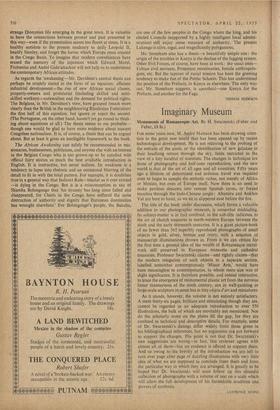Imaginary Museum
FOR some years now, M. Andre Malraux has been drawing atten- tion to the great new world that has been opened. up by recent technological development. He is not referring to the probing of the entrails of the atom, or the identification of new galaxies in their headlong retreat through the sky, fields restricted to the view of a tiny handful of scientists. The changes in technique are those of photography and half-tone reproduction, and the new world is that of the art of all ages and all countries. Fifty years ago a lifetime of determined and arduous travel was required even to begin to sample the aesthetic riches, not merely of Africa or Mexico, but even of Europe itself. Now there is no need to make perilous descents into remote Spanish caves, or forced marches through the Indo-Chinese jungle: Altamira and Ankhor Vat are here to hand, as we sit in slippered ease before the fire.
The title of the book under discussion, which forms a valuable addition to our photographic museum, is somewhat misleading. Its subject-matter is in fact confined, as the sub-title indicates, to the art of church treasures in north-western Europe between the ninth and the early thirteenth centuries. It is a giant picture-book of no fewer than 565 superbly reproduced photographs of small objects in gold, silver, bronze and ivory, with a selection of manuscript illuminations thrown in. From it we can obtain for the first time a general idea of the wealth of RoManesque metal- work still preserved in European museums and cathedral treasuries. Professor Swarzenski claims—atid rightly claims—that the modern relegation of such objects to a separate section, labelled somewhat contemptuously 'Minor Arts,' would have been meaningless to contemporaries, to whom mere size was of slight significance. It is therefore possible, and indeed instructive, to trace the emergence of monumental plastic art from the nervous linear mannerisms of the ninth century, not in wall-painting or large-scale sculpture in stone but in tiny objets d'art and miniatures.
LAWRENCE STONI










































 Previous page
Previous page